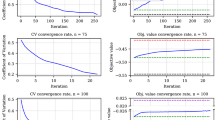Abstract
In this paper we introduce a new rank dependent utility approach, which unlike existing models, provides an SSD efficient portfolio as a function of the investors’ quantified risk aversion degrees. A parametric family of distortion functions is considered to model various levels of risk aversion. Under assumptions of equally probable scenarios, for any distortion function the corresponding optimization models can be expressed as linear program and easily solved. An empirical study is performed to compare the performance of our proposed model to the previously proposed portfolio selection models in the literature.






Similar content being viewed by others
Notes
There exist a number of different ways to consider the case of unequal probabilities. For example, as suggested by others (Roman et al. 2006), unequal probabilities can be handled by multiple replications of certain selected scenarios to achieve the desired probabilities. Another way to address this issue is to introduce a grid of level \(j\) that contain possible break points of the Lorenz curves. For instance, we may assume that the cumulative probability of returns for the bottom 10 % of the return distributions is 0.22, for the bottom 30 % of return is 0.40 and for 100 % of returns is 1.00.
Some of the descriptive statistics of the stocks are presented in Table 6 of Appendix.
References
Acerbi, C. (2002). Spectral measures of risk: A coherent representation of subjective risk aversion. Journal of Banking and Finance, 26(7), 1505–1518.
Denneberg, D. (1990). Distorted probabilities and insurance premiums. Methods of Operations Research, 63(1), 3–5.
Dentcheva, D., & Ruszczyski, A. (2003). Optimization with stochastic dominance constraints. SIAM Journal on Optimization, 14(2), 548–566.
Hanoch, G., & Levy, H. (1969). The efficiency analysis of choices involving risk. Review of Economic Studies, 36(107), 335–346.
Kopa, M., & Chovanec, P. (2008). A second-order stochastic dominance portfolio efficiency measure. Kybernetika, 44(2), 243–258.
Kuosmanen, T. (2004). Efficient diversification according to stochastic dominance criteria. Management Science, 50(10), 1390–1406.
Lehmann, E. L. (1955). Ordered families of distributions. The Annals of Mathematical Statistics, 26(3), 399–419.
Levy, H. (2010). Stochastic dominance: Investment decision making under uncertainty. Studies in Risk and Uncertainty. Springer. http://books.google.ca/books?id=dvJC8hvcZiMC
Linton, O., Maasoumi, E., & Whang, Y. (2005). Consistent testing for stochastic dominance under general sampling schemes. Review of Economic Studies, 72(3), 735–765.
Lizyayev, A. (2012a). Stochastic dominance: Convexity and some efficiency tests. International Journal of Theoretical and Applied Finance (IJTAF), 15(5), 1250,036-1–1250,036-19.
Lizyayev, A. (2012b). Stochastic dominance efficiency analysis of diversified portfolios: Classification, comparison and refinements. Annals of Operational Research, 196(1), 391–410.
Mansini, R., Ogryczak, W., & Speranza, M. G. (2007). Conditional value at risk and related linear programming models for portfolio optimization. Annals of Operations Research, 152(1), 227–256.
Markowitz, H. (1959). Portfolio selection: Efficient diversification of investments. New York: Wiley.
Ogryczak, W., & Ruszczynski, A. (2002). Dual stochastic dominance and related mean-risk models. SIAM Journal on Optimization, 13(1), 60–78.
Post, T. (2003). Empirical tests for stochastic dominance efficiency. Journal of Finance, 58(5), 1905–1932.
Post, T. (2008). On the dual test for ssd efficiency: With an application to momentum investment strategies. European Journal of Operational Research, 185(3), 1564–1573.
Pratt, J. W. (1964). Risk aversion in the small and the large. Econometrica, 32(1/2), 122–136.
Quiggin, J. (1982). A theory of anticipated utility. Journal of Economic Behavior and Organization, 3(4), 323–343.
Quiggin, J. (1993). Generalized expected utility theory: The rank dependent model. Berlin: Springer.
Quirk, J. P., & Saposnik, R. (1962). Admissibility and measurable utility functions. The Review of Economic Studies, 29(2), 140–146.
Rockafellar, R. T., & Uryasev, S. (2002). Conditional value-at-risk for general loss distributions. Journal of Banking & Finance, 26(7), 1443–1471.
Roman, D., Darby-Dowman, K., & Mitra, G. (2006). Portfolio construction based on stochastic dominance and target return distributions. Mathematical Programming Series, 108(2–3), 541–569.
Sereda, E. N., Bronshtein, E. M., Rachev, S. T., Fabozzi, F. T., Sun, W., & Stoyanov, S. V. (2010). Distortion risk measures in portfolio optimization. In Handbook of portfolio construction: Contemporary applications of Markowitz techniques, Chap. 25 (pp. 649–673). Springer.
Sriboonchitta, S., Nguyen, H., & Kreinovich, V. (2010). How to relate spectral risk measures and utilities. International Journal of Intelligent Technologies and Applied Statistics, 3(2), 141–158.
Wang, S. (1996). Premium calculation by transforming the premium layer density. Astin Bulletin, 26(1), 71–92.
Wirch, J., Hardy, M. (2001). Distortion risk measures: Coherence and stochastic dominance. http://www.meiss.com, http://www.gloriamundi.com
Yaari, M. E. (1987). The dual theory of choice under risk. Econometrica, 55(1), 95–115.
Author information
Authors and Affiliations
Corresponding author
Appendix
Appendix
Table 6 shows some of the descriptive statistics of 15 stocks, S1–S15, for the sample period. The Jarque–Bera test at 95 % confidence level confirms that majority of stocks have non-normal and asymmetric return distributions.
Rights and permissions
About this article
Cite this article
Javanmardi, L., Lawryshyn, Y. A new rank dependent utility approach to model risk averse preferences in portfolio optimization. Ann Oper Res 237, 161–176 (2016). https://doi.org/10.1007/s10479-014-1761-9
Published:
Issue Date:
DOI: https://doi.org/10.1007/s10479-014-1761-9




